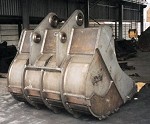Welding Different Types of Steel
Or how to weld just about anything. This section summarisess the welding procedures and filler materials you might need for the more commonly available types of steel and iron and was was funded by forum supporters.
Mild Steel
Welding mild steel is straightforward up to 18mm thick. Low hydrogen consumables and preheat might be necessary for thicker sections.
Engineering Steels
EN19, EN24/EN24T and EN8 are engineering steels specified for their high strength. Consumables and preheating are normally specified to prevent Hydrogen induced cracking.
Corten
A weathering steel which turns orange in time, special fillers are required for thicker section so the weld weathers like the plate.
Cast Iron
Cast iron is not very malliable and can crack with the thermal expansion and contraction of welding. Soft consumables are generally used to weld cast iron.
Weldox
High strength steels often used in the manufacture of digger buckets and skips. Consumables are chosen to match the strangth of the steel.
Cast and Manganese Steels
Casting is purely the means of creating the shape, same as forging and rolling. Therefore it could be any grade from dead mild steel to Stainless.
Hardox
This high hardness steel is normally found on the edges of digger buckets. Preheating is normally required to prevent cracking.
Wrought Iron
Widely used until the late 19th centuary, wrought iron is corrosion resistant and easy to work, but is not really suitable for welding due to slag layers.
Stainless Steel
Consumables are chosen to match or exceed the chromium content of the parent metal.
Hardfacing
A hard, abrasion resistant bead of weld used on exposed surfaces of digging and quarying machinary.
Chrome Moly
This corrosion resistant steel is widely used in power stations due to it's creep resistance, and pre and post heat are required for thick sections.
Hydrogen Embrittlement
The theory about why welds crack and why low hydrogen filler materials are specified for many thick or high strength steels.
Credits
This section was written by Alan Mayfield who has 33 years experience (so far) with welding consumable manufacturers working and advising on development, production and use of MMA, MIG, TIG, FCW and Sub Arc products.
Following on from the Harry Brearley story (under stainless steel) My father worked for Brown - Bayley Steels, as did Harry Brearley. The Admiralty started making welding rods in Sheffield in the 1920’s. When war broke out they wanted to increase their output so they asked Harry Brearley for help. He set up a Welding Rod manufacturing section within Brown Bayleys. After the war the welding rod manufacturing division was privatised, still with Brearley as Technical Director, and became Welding Rods Ltd. I joined them in 1977 and some years later they were taken over by Lincoln Electric.
Photos
Thanks to everyone who gave permission to use their photos. I've added credits in the photo captions where possible.


